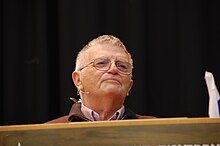
Ehud Netzer
Ehud Netzer | |
|---|---|
 | |
| Born | 13 May 1934 Jerusalem |
| Died | 28 October 2010 (aged 76) Jerusalem |
| Occupation(s) | Architect, archaeologist and educator |
Ehud Netzer (Hebrew: אהוד נצר 13 May 1934 – 28 October 2010[1]) was an Israeli architect, archaeologist and educator, known for his extensive excavations at Herodium, where in 2007 he found the tomb of Herod the Great;[2] and the discovery of a structure defined by Netzer as a synagogue, which if true would be the oldest one ever found (the "Wadi Qelt Synagogue").

Netzer served as a professor at the Institute of Archaeology at the Hebrew University in Jerusalem. He was a world-renowned expert on Herodian architecture. Netzer worked at Masada with Yigael Yadin, and later completed the official excavation report for the site. He later led teams of archaeologists like Rachel Chachy, who did important fieldwork at the Herodian palace at Jericho. At Herodium, in the desert near Bethlehem and south of Jerusalem, for more than three decades, Netzer oversaw extensive excavations focusing on remains at the foot and on the sides of the artificial mountain.[3][4]

Biography
Ehud Netzer was born in Jerusalem in 1934 to Israeli educators Joseph and Puah Menczel. Netzer was reported to have changed his surname from Menczel to Netzer because of the complexity and recurring mistakes in spelling his name in the Hebrew language.[5] He graduated with a degree in architecture from the Technion in 1958. As an undergraduate, Netzer would spend his summer vacation in excavations of the noted archaeologist Yigael Yadin.[5]

While working as a co-architect in excavations in Masada, Netzer met his future wife, Devorah Dove, an archeology student.[6] He later obtained a Ph.D. in the field of archaeology from Hebrew University of Jerusalem.

He became a professor at the Institute of Archaeology at Hebrew University. Netzer was eventually recognized as the world's foremost authority on Herodian architecture.[7]

Archaeological and architectural career
Netzer initiated and directed excavations at several building projects of Herod the Great, the ancient king of Judea. In the mid-1960s, Netzer was co-architect, together with I. Dunayevsky, of the excavations at Masada, directed by Professor Yigael Yadin. After Yadin's death, Netzer completed the final excavation report The Buildings, Stratigraphy and Architecture of Masada. Later, Netzer directed the restoration of the Masada site on behalf of Israel's National Parks Authority.[7]

Netzer was head architect for the restoration and excavation of the Jewish Quarter in Jerusalem (1967-1975); the planner of the restoration of the Jewish neighborhoods in Jerusalem, Mishkenot Sha'ananim, and Yemin Moshe; and planned public buildings in Egypt.[5][8]

In 1968, Netzer initiated and directed large-scale excavations at the site of Herod's winter palace at Jericho.[9][10][11]

In 1972, he began excavating at the huge palace complex of Herodium, located in the desert outside Bethlehem. His first phase of work continued to 1987, as he excavated palace structures. He returned to the dig from 1997–2000, and again from 2000–2010.[12] The ancient Jewish historian, Josephus Flavius, had written that Herod's tomb was located at his fortified palace of Herodium.[11]

From 1972-78, Netzer completed his Ph.D. dissertation at the Hebrew University's Institute of Archaeology on the subject of Herod's palaces at Herodium and Jericho. He became a senior lecturer at the university in 1981 and a professor in 1990. The subjects he taught combined architecture and archaeology. From 1985-93, he directed the Hebrew University expedition to Zippori (Sepphoris) in the lower Galilee, which exposed a synagogue. Its mosaic floor has been exhibited in the Jewish Museum in New York City.

Herodium
Herodium is an enormous, cone-shaped, partially man-made mountain holding a fortress palace built by Herod just outside Bethlehem. According to the ancient Romano-Jewish historian Josephus, Herodium was the site of Herod's burial.[11] Enclosed within the artificial hill was a fortress palace, which had previously been the focus of excavations led in 1962-67 by Virgilio Canio Corbo and Stanislao Loffreda from the Studium Biblicum Franciscanum of Jerusalem. Netzer began work on the extensive palace complex at the foot of the hill, which he labeled as "Lower Herodium".

From 1972–87, Netzer worked at Herodium, excavating the palace structures. He resumed work on the dig from 1997–2000, and again from 2000–2010. Beginning in 2006, excavations revealed a ramp winding around the hill from the lower palace complex and stadium. Along its path were discovered a theater and a monumental staircase, which led past a platform and remains which, in May 2007, Netzer identified as the probable tomb of King Herod.[12] Netzer found the sarcophagus "shattered into hundreds of pieces", as described by Josephus, who wrote that it was done "by Jewish dissidents during the first revolt against the Romans between AD 66 and 72."[1]

In October 2013, archaeologists Joseph Patrich and Benjamin Arubas challenged the identification of the tomb as that of Herod.[13] According to Patrich and Arubas, the tomb is too modest to be Herod's and has several unlikely features.[13] Roi Porat, who replaced Netzer as excavation leader after the latter's death, stood by the identification.[13]

Jericho
Netzer excavated at Jericho from 1973, and continued working there over the next decade.[7] At the oasis of Jericho, he uncovered new wings of Herod's winter palace, as well as a Hasmonean winter palace containing a number of swimming pools and gardens. This is the major archaeological site to have survived from that period in Jewish history. The complex includes a structure built 70-50 BCE and identified in 1998 by Netzer as a synagogue, which has been contested, but if proven true would be the oldest synagogue that has ever been found (the "Wadi Qelt synagogue").[14]

Private life; death
He married Devora and they had four children, all of whom live in Israel: Chana, Ruti, Yael and Yossef.

On 25 October 2010, Netzer fell and was seriously injured when a railing gave way at the dig at Herodium. He died of his injuries three days later at Hadassah Ein Kerem hospital in West Jerusalem.[15]

Published works
- The architecture of Herod, the great builder, Mohr Siebeck, Tübingen 2006 (Texts and studies in ancient Judaism, Bd. 117) ISBN 3-16-148570-X
- The Hebrew University excavations at Sepphoris during the years 1992-1996. Qadmoniot. No. 113, pp 2–21, 1997
- "Architectural development of Sepphoris during the Roman and Byzantine Periods", in: Archaeology and the Galilee: Texts and Contexts. pp. 117–130, 1997
- Promise and Redemption: A Synagogue Mosaic from Sepphoris, Jerusalem: Israel Museum, 44 pp., 1996
- "New evidence for Late Roman and Byzantine Sepphoris", in: The Roman and Byzantine Near East: Recent Archaeological. 1995, pp 162–176
- Zippori, Jerusalem: Israel Exploration Society, 71 pp., 1994
- "Byzantine mosaics at Sepphoris: New finds", Israel Museum Journal. No. 10, pp 75–80, 1992
- The Palaces of the Hasmoneans and Herod the Great. Yad Ben-Zvi. 2001. ISBN 978-965-217-187-0.
- The Architecture of Herod, the Great Builder. Baker Academic. 2008. ISBN 978-0-8010-3612-5.
References
- ^ a b Maugh II, Thomas H. (5 November 2010). "Ehud Netzer dies at 76; archaeologist unearthed Herod the Great's tomb". Los Angeles Times. Retrieved 24 September 2015.
- ^ Dina Kraft (9 May 2007). "Archaeologist Says Remnants of King Herod's Tomb Are Found". NYTimes. Retrieved 24 September 2015.
- ^ "Archeologist: King Herod's Tomb Desecrated, but Discovery 'High Point'". Haaretz. 7 May 2007. Retrieved 24 September 2015.
- ^ "Israeli Archaeologist May Have Found Tomb of King Herod". FOX News. 7 May 2007. Retrieved 24 September 2015.
- ^ a b c Dove, Aytan (2010-12-07). "Ehud Netzer obituary". The Guardian. ISSN 0261-3077. Retrieved 2016-03-14.
- ^ Burrell, Barbara. "Remembering Ehud Netzer (1934-2010)." Herodium.com. The institute of Archeology, the Hebrew University of Jerusalem. N.d. http://herodium.org/wp-content/uploads/2014/nezer/Remembering%20Ehud%20Netzer-Burrel.pdf
- ^ a b c Shanks, Hershel (January/February 2011). "Milestones: Ehud Netzer (1934–2010)". Biblical Archaeology Review. Washington, D.C.: The Biblical Archaeology Society, 37 (1): 22. ISSN 0098-9444
- ^ Burrell, Barbara. "Remembering Ehud Netzer (1934-2010)." Herodium.com. The institute of Archeology, the Hebrew University of Jerusalem. N.d. http://herodium.org/wp-content/uploads/2014/nezer/Remembering%20Ehud%20Netzer-Burrel.pdf
- ^ "King Herod's tomb unearthed, Israeli university claims" Archived 2007-05-10 at the Wayback Machine, CNN, 7 May 2007
- ^ Herod's Tomb Discovered Archived 2007-08-14 at the Wayback Machine, IsraCast, 8 May 2007.
- ^ a b c Matthew Kalman, "Herod's tomb reportedly found inside his desert palace" The Boston Globe 8 May 2007.
- ^ a b Netzer, Ehud (January/February 2011). "In Search of Herod's Tomb". Biblical Archaeology Review. Washington, D.C.: The Biblical Archaeology Society, 37 (1): 36, 40, 42, 44–47. ISSN 0098-9444
- ^ a b c Nir Hasson (11 October 2013). "Archaeological stunner: Not Herod's Tomb after all?". Haaretz. Retrieved 24 September 2015.
- ^ "Oldest Synagogue Found in Israel". The Associated Press. 29 March 1998. Archived from the original on 24 September 2015. Retrieved 26 January 2009.
- ^ "Ehud Netzer, Archeologist Who Located Herod's Tomb, Dies at 76". Haaretz. 28 October 2010.
External links
- Expert on architecture of Herod the Great gives lecture 28 September, Cornell Chronicle, New York, 23 September 1999.
- Ehud Netzer Faculty page at Hebrew University of Jerusalem
- 1934 births
- 2010 deaths
- Accidental deaths from falls
- Accidental deaths in Israel
- Academic staff of the Hebrew University of Jerusalem
- Israeli archaeologists
- People from Jerusalem
- Israeli architects
- Hebrew University of Jerusalem alumni
- Technion – Israel Institute of Technology alumni
- 20th-century archaeologists
- 21st-century archaeologists
See what we do next...
OR
By submitting your email or phone number, you're giving mschf permission to send you email and/or recurring marketing texts. Data rates may apply. Text stop to cancel, help for help.
Success: You're subscribed now !
